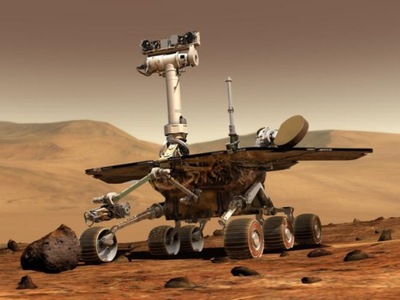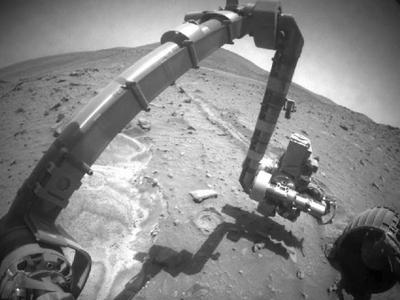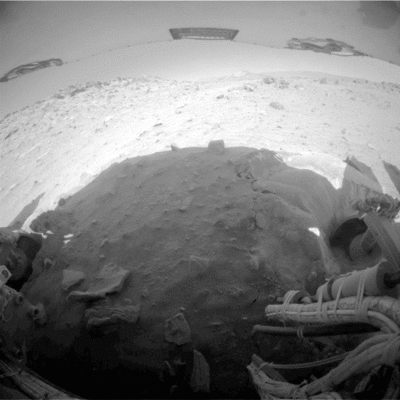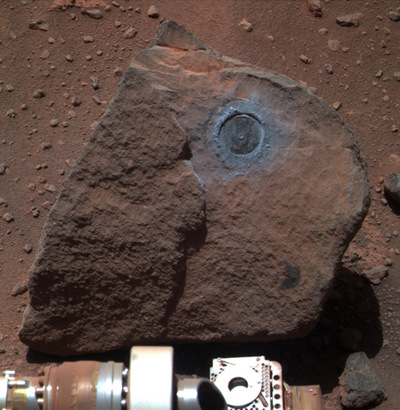 |
|
An artist's concept portrays a NASA Mars Exploration Rover on the surface of Mars.
Image credit: NASA/JPL/Cornell University
|
| |
Spirit Switches to Backward Drives
20 January 2010
The rover team has begun driving
Spirit backward as next technique for attempting to extricate the rover from the sand trap where it is embedded.
The first two backward drives produced about 6.5 centimeters (2.6 inches) of horizontal motion and lifted the rover slightly.
Spirit performed the first backwards drive (toward the south) on Sol 2045 (Jan. 14, 2010). Until then, all drives since extrication attempts began two months earlier had been with forward driving, with Spirit facing northward.
The rover first entered its present location driving backward in April 2009.
The backward driving in recent days includes the additional technique of steering the wheels side-to-side before performing each step.
The hypothesis for the wheel steering is two-fold.
The process clears out material in front of the wheel and allows material to slough off the face of the wheel trench and provide traction under the wheel. Also, the flat surface of the wheel's side "kicks" against loose material, like a swimmer's frog kick or breast stroke, to provide some push.
This Sol 2045 drive included enough wheel rotations to move the rover backward about 30 meters (98 feet) in six steps of 5 meters (16 feet) each, if the rover were in a situation with good traction. However, as Spirit is in a sand trap, the drive moved the rover backward a total of just over 3 centimeters (1.2 inches) and raised it in altitude just over 1 centimeter (0.4 inch).
This is the first time the rover has climbed since extrication attempts began.
Northerly tilt also improved by just over a degree.
The explanation here is that the rover's rear wheels are climbing, raising the back of the rover. Images from the rear hazard avoidance camera confirm this. A tilt toward the north would be favorable for energy production in the coming Martian winter, as it would gain more sunshine on the solar array.
A second backward drive was commanded on Sol 2047 (Jan. 16, 2010).
It was also six steps of 5 meters backward with the steering "frog kicks." The rover moved about 3.5 centimeters (1.4 inches) backward and climbed 0.3 centimeters (0.1 inch). However, this time the northerly tilt deteriorated by over a degree, undoing the prior drive's improvement.
The explanation here is that the rover yawed counterclockwise, swinging the angled solar arrays away from north. But the rear wheels continued to climb, suggesting that the middle wheels are gaining traction.
The rover is now about 3.5 centimeters (1.4 inches) south of the point where it started extrication two months ago, meaning the backward driving has already covered all of the distance achieved with forward driving and then some.
 |
|
Spirit and its twin, Opportunity, have been working on Mars for more than 58 months in what were originally planned as 3-month missions on Mars.
Image Credit: NASA/JPL-Caltech
|
| |
Spirit is still down about 3 centimeters (1.2 inches) in altitude since extrication started.
It is important to remember that the right-rear wheel is still non-functional, along with the right-front wheel.
On Sol 2050 (Jan. 19, 2010),
Spirit was commanded to drive further backwards.
Partway through the drive, the rover's left middle wheel stalled.
Activities planned for coming sols include getting more diagnostic information about that wheel stall.
Even with four working wheels,
Spirit would have a very difficult path to extrication. And the rover needs a much better northerly tilt to assure winter survival.
As for other techniques to consider for extrication, the rover team has examined the two options that would use the robotic arm: pushing with it and re-sculpting the terrain by the left-front wheel.
The assessment of pushing with the arm reveals that only about 30 newtons of lateral force could be achieved, while a minimum of several hundreds of newtons would be needed to move the rover.
Further, such a technique risks damaging the arm and preventing its use for high-priority science from a stationary rover.
The other technique of re-sculpting the terrain and perhaps pushing a rock in front of or behind the left-front wheel is also assessed to be of little to no help and, again, risks the arm. There is also a large risk of accidentally pushing the rock into the open wheel and jamming.
http://www.nasa.gov/mission_pages/mer/freespirit.html
Spirit's Robotic Stretch
NASA's Mars Exploration Rover Spirit recorded this forward view of its arm and surroundings during the rover's 2,052nd Martian day, or sol, on Oct. 11, 2009.
Bright soil in the left half of the image is loose, fluffy material churned by the rover's left-front wheel as
Spirit, driving backwards, approached its current position in April 2009 and the wheel broke through a darker, crusty surface.
 |
|
The rover team began commanding extrication drives in November after months of Earthbound testing and analysis to develop a strategy for attempting to drive Spirit out of this soft-soil site, called "Troy." The extrication drives have made little progress and the probability of getting Spirit out of the sand trap is low.
Image Credit: NASA/JPL-Caltech
|
| |
Spirit used its front hazard-avoidance camera to take this image.
The turret of tools at the end of the rover's robotic arm is positioned with the
Moessbauer spectrometer up and the rock abrasion tool extending toward the right.
Spirit's right-front wheel, visible in this image, has not worked since 2006. It is the least-embedded of the rover's six wheels at the current location, called "
Troy."
Spirit and its twin,
Opportunity, have been working on
Mars for more than 58 months in what were originally planned as 3-month missions on
Mars.
Sample from Deep in Martian Crust: “Marquette Island”
21 January 2010
PASADENA, Calif. - NASA's Mars exploration rover Opportunity is allowing scientists to get a glimpse deep inside
Mars.
Perched on a rippled Martian plain, a dark rock not much bigger than a basketball was the target of interest for
Opportunity during the past two months.
Dubbed "
Marquette Island," the rock is providing a better understanding of the mineral and chemical makeup of the
Martian interior.
 |
|
NASA's Mars Exploration Rover Opportunity examined a rock called "Marquette Island" from mid-November 2009 until mid-January 2010. Studies of texture and composition suggest that this rock, not much bigger than a basketball, originated deep inside the Martian crust. A crater-digging impact could have excavated the rock and thrown it a long distance, to where Opportunity found it along the rover's long trek across the Meridiani plain toward Endeavour Crater.
This approximately true-color view of Marquette Island comes from combining three exposures that Opportunity's panoramic camera (Pancam) took through different filters during the rover's 2,117th Martian day, or sol, on Mars (Jan. 6, 2010). On the preceding sol, Opportunity's rock abrasion tool brushed dust out of the circular area where that tool had ground into the rock on sols 2100 and 2103 (Dec. 20 and 23, 2009). The dark circle left by the rock abrasion tool's work is approximately 5 centimeters (2 inches) in diameter.
Image Credit: NASA/JPL-Caltech/Cornell
|
| |
"Marquette Island is different in composition and character from any known rock on Mars or meteorite from Mars," said
Steve Squyres of Cornell University in Ithaca, N.Y.
Squyres is principal investigator for Opportunity and its twin, Spirit. "It is one of the coolest things Opportunity has found in a very long time."
During six years of roving,
Opportunity has found only one other rock of comparable size that scientists conclude was ejected from a distant crater.
The rover studied the first such rock during its initial three-month mission.
Called "
Bounce Rock," that rock closely matched the composition of a meteorite from
Mars found on
Earth.
Marquette Island is a coarse-grained rock with a basalt composition.
The coarseness indicates it cooled slowly from molten rock, allowing crystals time to grow. This composition suggests to geologists that it originated deep in the crust, not at the surface where it would cool quicker and have finer-grained texture.
"It is from deep in the crust and someplace far away on Mars, though exactly how deep and how far we can't yet estimate," said
Squyres.
The composition of
Marquette Island, as well as its texture, distinguishes it from other Martian basalt rocks that rovers and landers have examined.
Scientists first thought the rock could be another in a series of meteorites that
Opportunity has found. However, a much lower nickel content in
Marquette Island indicates a
Martian origin.
The rock's interior contains more magnesium than in typical Martian basalt rocks
Spirit has studied.
Researchers are determining whether it might represent the precursor rock altered long ago by sulfuric acid to become the sulfate-rich sandstone bedrock that blankets the region of
Mars that
Opportunity is exploring.
"It's like having a fragment from another landing site," said
Ralf Gellert of the University of Guelph, in Ontario, Canada.
Gellert is lead scientist for the alpha particle X-ray spectrometer on Opportunity's robotic arm. "With analysis at an early stage, we're still working on some riddles about this rock."
The rover team used
Opportunity's rock abrasion tool to grind away some of
Marquette Island's weathered surface and expose the interior.
This was the 38th rock target
Opportunity has ground into, and one of the hardest.
The tool was designed to grind into one
Martian rock, and this rock may not be its last.
"We took a conservative approach on our target depth for this grind to ensure we will have enough of the bit left to grind the next hard rock that Opportunity comes across," said
Joanna Cohen of Honeybee Robotics Spacecraft Mechanisms Corp., in New York, which built and operates the tool.
Opportunity currently is about 30 percent of the way on a 12-mile trek begun in mid-2008 from a crater it studied for two years.
It is en route toward a much larger crater,
Endeavour.
The rover traveled 3.3 miles in 2009, farther than in any other year on
Mars.
Opportunity drove away from
Marquette Island on Jan. 12.
"We're on the road again," said
Mike Seibert, a rover mission manager at NASA's Jet Propulsion Laboratory in Pasadena, Calif.
"The year ahead will include lots more driving, if all goes well. We'll keep pushing for Endeavour crater but watch for interesting targets along the way where we can stop and smell the roses."
Since landing on
Mars in 2004,
Opportunity has made numerous scientific discoveries, including the first mineralogical evidence that
Mars had liquid water.
After working 24 times longer than originally planned,
Opportunity has driven more than 11 miles and returned more than 133,000 images.
JPL manages the rovers for
NASA's Science Mission Directorate in Washington.
For more information about the rovers, visit:
http://www.nasa.gov/rovers
Dwayne Brown
Headquarters, Washington
202-358-1726
dwayne.c.brown@nasa.gov
Guy Webster
Jet Propulsion Laboratory, Pasadena, Calif.
818-354-6278
guy.webster@jpl.nasa.gov
http://www.nasa.gov/mission_pages/mer/news/mer20100121.html

